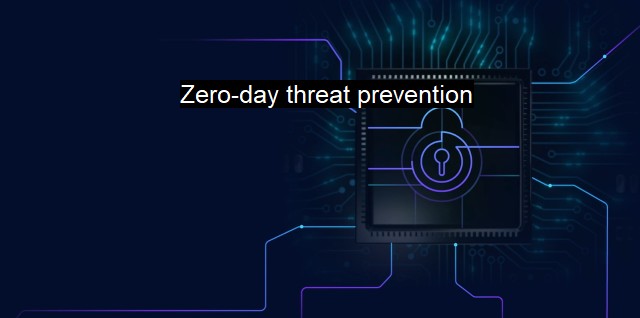What is Zero-day threat prevention?
Understanding Zero-Day Threat Prevention: A Vital Tool in Cybersecurity to Minimize the Risk of Online Attacks
The term "Zero-Day threat prevention" in the context of cybersecurity and antivirus denotes a crucial part of any security framework aimed at proactively guarding against unknown vulnerabilities that can be exploited by adversaries. a zero-day threat is a vulnerability in a system that is unknown to the ones responsible for rectifying the system, and thus informs the crux of a 'zero-day attack'.In the digital age, where cyber capabilities have become intricacies of power dynamics and the security of confidential and sensitive data has become a high-stakes game, comprehending the dynamics of zero-day threats assumes primary importance. Despite vast investments in security apparatus, firms, governments, and individuals continue to remain susceptible to cyber threats owing to their increasing sophistication and rapid advancement.
A distinguishing factor about a zero-day threat is its lack of visibility. They are unknown vulnerabilities, often discovered by hackers before the developers or security teams themselves. By definition, there are no available patches or prior defense methodologies that can be employed to counter zero-day threats. They exploit secretive holes in software, gradually leading to the compromise of the system or network.
Zero-day threats pose a real danger for several reasons. Firstly, such attacks can pass undetected through most cryptographic defenses, as they exploit unknown weaknesses. They have the ability to compromise systems, glean confidential data, and potentially cause massive disruptions before being detected, which augments their lethality. Industries such as healthcare, finance, and defense are particularly susceptible to these attacks, given the nature of data they handle.
It's in this light that zero-day threat prevention comes into the picture. As the name suggests, this set of measures is designed to prevent zero-day attacks proactively, rather than reacting after the system has already been penetrated. These preventive measures incorporate threat intelligence, strong perimeter defenses, micro-segmentation of access, secure system design, ongoing system updates and patches, deliberate obscurity and incident response plans into a comprehensive security framework.
Zero-day threat prevention encourages developing secure code, cultivating penetration testing, and continuous reassessment of potential new threats. The deployment of artificial intelligence and machine learning to predict and identify potential vulnerabilities can give businesses a fighting chance against the constantly evolving global threat landscape.
Zero-day threat prevention is not just a technology issue. It embraces the ethos of creating a cybersecurity culture where employees are educated about the best practices for cyber hygiene and are alert to any suspicious activities. Threat modeling, prioritization of assets, and investment in the right security tools all play an integral part in zero-day threat prevention.
Equally important within the realms of zero-day threat prevention is the incident response mechanism that gets activated once a vulnerability has been identified. At this time, it becomes key to have a team of computer forensics experts who can mitigate the damage and patch the vulnerabilities swiftly.
The importance of understanding and responding to zero-day threats cannot be overstressed in an increasingly digital and interconnected world. The ability to pre-empt, understand and effectively contain a zero-day threat goes beyond strengthening individual and organisational cyber hygiene—it has a considerable impact on a national and global scale. As we redefine our limitations and boldly traverse in an era of cutting-edge advancements and evolving cyber threat mechanisms, it will become exceedingly paramount for us to add highest degree of proficiency in zero-day threat prevention to our repertoire to tactfully navigate these cyber terrains.

Zero-day threat prevention FAQs
What is zero-day threat prevention?
Zero-day threat prevention is a cybersecurity strategy that involves detecting and blocking attacks that exploit previously unknown vulnerabilities in software or systems. These vulnerabilities, also known as zero-day vulnerabilities, have not yet been identified or patched by the software vendor.How does zero-day threat prevention work?
Zero-day threat prevention works by utilizing various techniques such as behavior monitoring, machine learning, and heuristic analysis to identify and block threats that are unknown or have never been seen before. It can also rely on threat intelligence feeds to identify and block new threats as they emerge.Why is zero-day threat prevention important?
Zero-day threat prevention is important because it helps organizations defend against attacks that are designed to evade traditional security measures. These attacks can be particularly dangerous as they can be used to steal sensitive information, disrupt business operations, and even take control of entire networks.How can I implement zero-day threat prevention in my organization?
To implement zero-day threat prevention in your organization, you should start by assessing your current security posture to identify any gaps or weaknesses. From there, you can deploy advanced security solutions that incorporate zero-day threat prevention capabilities. It is also important to stay up-to-date with the latest threat intelligence and ensure that your security policies and procedures are regularly reviewed and updated.| | A | | | B | | | C | | | D | | | E | | | F | | | G | | | H | | | I | | | J | | | K | | | L | | | M | |
| | N | | | O | | | P | | | Q | | | R | | | S | | | T | | | U | | | V | | | W | | | X | | | Y | | | Z | |
| | 1 | | | 2 | | | 3 | | | 4 | | | 7 | | | 8 | | |||||||